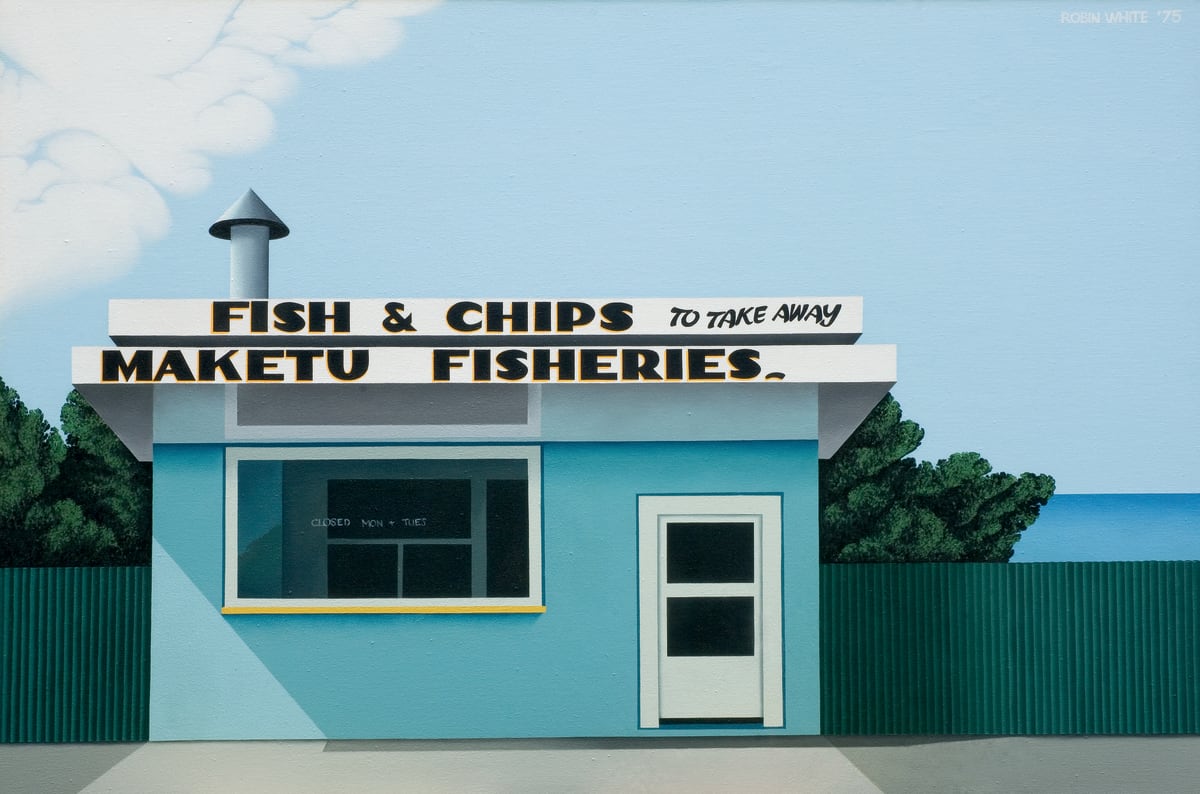
New Zealand's best art writer on a classic image
It’s 16 months since I’ve been back to New Zealand – the longest time I’ve ever spent away – and I’m looking at Robin White’s painting from 1975 of the Maketū fish and chip shop and thinking of what changes and what stays.
When I’m back, I know, things will have changed in that now-expected Covid way: friends a little greyer, ’tweens now adults, some laughter lines, some absences, some new arrivals. Looking at Maketū’s fish and chip shop on the Google Street View archive, I can see that its face, too, has changed. In the 2010s someone paid homage to the painting (life imitating art) by returning the shop to its original aqua blue and redoing its old-school signwriting. In the most recent photo, it’s been renamed Te Ika a Maui Wharekai and embellished with a brilliant lime-green mural of a food basket.
"My, how things have changed. Such is life," Robin wrote to me when I sent her screenshots of the streetscape – and so it is. Even when we feel like we’re standing still, time is streaming round us, through us. We’re shedding cells, shoring up our sandcastles, leaning into the headwinds of entropy. Yet oddly, when I look at Robin’s almost 50-year old painting, I’m calmed and reassured. Because sometimes, in this storm of loss, someone makes something that quells the commotion – doesn’t stop time exactly (as if that were possible), but holds a moment so we can consider it.
The sun rises every day on the former Maketū fish and chip shop in the history-drenched Bay of Plenty. But look at how carefully the young Robin White worked to hold, to benignly trap, one such late-morning moment, taking the sacred and ancient construction kit called geometry (as used by Piero della Francesca in the 1400s, and the common property of all willing painters since) and putting it to use in this blink-and you’ll-miss-it township. A triangle of light settles just so on the bottom-left corner of the shopfront, whose surface reflects light back on to the footpath at corresponding angles. The hood of the ventilation shaft participates in this colloquy of triangles, while pointing upward to a soft incoming isosceles of cloud.
A slip of spelling would give us, at this point, angels rather than angles, and it happens that Robin’s teacher Colin McCahon, the religious modernist who "saw an angel in this land", can also be seen in this painting – where a building reflected in the fish-and-chip-shop window is also a McCahon cross hovering in blackness, beneath white signwriting that announces (a believable prophecy) "CLOSED MON + TUES". In a pedantically realist painting we might expect to see the artist reflected in that window. But Robin, remember, is in charge of time in the provisional paradise of her painting, and she’s stepped out, moved on, absented herself, leaving the street uncannily empty.
I’m not here to say that it’s symbolic or metaphysical. It’s the fish and chip shop, Maketū. But the quietude and emptiness Robin built into her painting are why it is enduring. It holds a moment for us to be in. It turns what was into a magically lucid is. And it sends you out into its blessedly blue Pacific day with a beautiful last word: away.
Extracted with permission from Robin White: Something is Happening Here edited by Sarah Farrar, Jill Trevelyan and Nina Tonga ($70, Te Papa Press and Auckland Art Gallery Toi o Tāmaki) available in bookstores nationwide. ReadingRoom is devoting all week to this beautiful pictorial biography of White's career. Yesterday: Steve Braunias on "the beautiful collaboration" between White and Sam Hunt. Tomorrow: in her own words, Robin White on her Bahá'í Faith.
A major retrospective exhibition featuring more than 50 of White's works is now on show at Te Papa until September 18, and will then open at Auckland Art Gallery in late-October 2022.








